Episode 216
What you’ll learn in this episode:
- Why artist jewelry is more than just miniature versions of larger work
- The history of artist jewelry, and how Esther is helping its story continue
- How Esther helps artists with their first forays into jewelry, and why making jewelry can be a fruitful challenge for fine artists
- Why an artist’s first idea for a piece of jewelry is often not their best
- Why artist jewelry collectors must be brave
About Esther de Beaucé
Esther de Beaucé is the founder and owner of Galerie MiniMasterpiece in Paris, France. MiniMasterpiece is a gallery entirely dedicated to contemporary artists, designers and architects’ jewelry. The gallery is an invitation given to those who usually never design jewelry because their work evolves on a more monumental scale (i.e. sculptures). Esther’s passion is to convince those artists to change the scale of their work and accompany them in that new field of wearable art. She has collaborated with acclaimed contemporary artists such as Phillip King, Bernar Venet, Andres Serrano, Lee Ufan, Jean-Luc Moulène, and Pablo Reinoso.
A graduate of Brown University, Esther previously co-owned the gallery Schirman & de Beaucé in Paris, dedicated to young artists of contemporary art.
Photos:
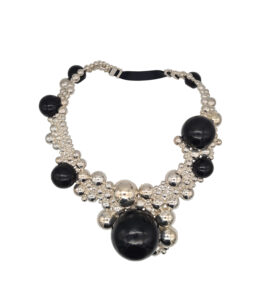
1 – “Extravaganza” necklace by franco-portuguese artist JOANA VASCONCELOS
in sterling silver and lacquer. It is a unique piece that was made in 2022 for the gallery’s 10th birthday.
Vasconcelos is a fantastic contemporary artist and Extravaganza is her first art jewel. The making of this piece was a great challenge –
over 250 hollowed silver spheres to combine !
© MiniMasterpiece
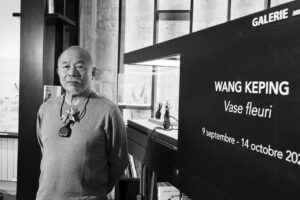
2 – Chinese artist WANG KEPING at the gallery during his jewelry solo show in 2022.
© Michel Lunardelli
I love my collaboration with Keping – he is a great artist and a beautiful human being. We plan on working again together in 2024.
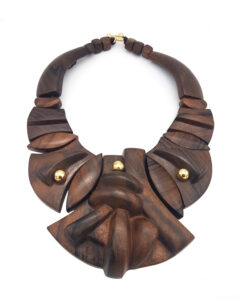
3 – “Hyperion” necklace by greek artist SOPHIA VARI
in ziricote wood and 18k yellow gold, 2022, edition of 3 + 2AP
Vari, who passed away earlier in May 2023, was one of the very first artist I worked with.
She was amazingly talented. Her jewels are both powerful and very sophisticated. She is very missed by all jewelry lovers.
© MiniMasterpiece
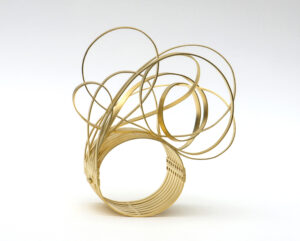
4 – “Loopingcuff” by argentinian artist PABLO REINOSO
in sterling silver plated 18k yellow gold. One of the most beautiful cuff I edited (2018 – edition of 8).
As beautiful on the body as left a small sculpture.
© MiniMasterpiece
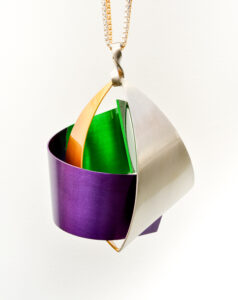
5 – “Liaisons amoureuses” pendant by english artist PHILLIP KING
in 18k yellow gold, sterling silver and lacquer, made in 2017 in an edition of 10.
In february 2024, I will show his most recent jewels – 3 never seen before sculptures-to-wear
that he sent me the day before he passed away in 2021.
© Yann Delacour
Additional Resources:
Transcript:
For gallerist Esther de Beaucé, artist jewelry isn’t completely art or completely contemporary jewelry. It’s in a niche all its own—and that’s what makes it fascinating. As founder and owner of Galerie MiniMasterpiece in Paris, she helps fine artists translate their art into jewelry, creating something entirely new rather than a smaller version of their typical work. She joined the Jewelry Journey Podcast to talk about how she challenges artists to think about their work differently; how interest in artist jewelry has evolved over the years; and why artist jewelry collectors are so open minded. Read the episode transcript here.
Sharon: Welcome to the Jewelry Journey, exploring the hidden world of art around you. Because every piece of art has a story, and jewelry is no exception.
Hello, everyone. Welcome to the Jewelry Journey Podcast. This is the second part of a two-part episode. If you haven’t heard part one, please head to TheJewelryJourney.com.
I don’t remember how I found out about Esther de Beaucé’s gallery in Paris. It is tucked back in the corner with other galleries. Welcome back.
Do you have collectors, people who like a certain artist or piece they’ve found in your gallery, and then they come back and look for others, or you send them a postcard telling them, “We’re having a show of that artist,” or something like that?
Esther: Yes. I have shows at the gallery as well, maybe for a year. Most of the time they are solo shows. I like solo shows a lot because it’s like for art, when when you have a solo show, you’re surrounded by several pieces of work. You are emerging into their body of work. It’s more interesting to me than having one piece by that artist and another piece by another artist. I like solo shows a lot, but solo shows are not easy to make because it means that obviously the artist had several ideas. It takes a lot of time to organize a solo show, but I try to make solo shows most of the time. I invite all my collectors to these shows.
It’s always difficult to know what’s going to happen between a collector and a piece of jewelry, what connection is going to operate at that time. Sometimes collectors choose or fall for an object, and they don’t know the artist who’s behind it, but they really fall for an object. I really like that idea. Sometimes collectors are very close to an artist, and they have several pieces of that artist in their homes. When they realize that artist has also made a piece of jewelry, then of course they’re going to be interested in it. Most of the jewels I have at the gallery, I hope they speak for themselves. You were asking me about collectors and jewelry.
Sharon: You answered the question. But do have people who only collect, let’s say, Pablo Picasso’s jewelry or something that?
Esther: Yeah, of course. Some women only wear silver or only wear gold or only wear rings or never wear any brooches. I try to remember all that so I can show them what they like. But I also enjoy presenting them with other things, too, because it’s always interesting to make discoveries.
And the collectors of artist jewelry are very open-minded people. It takes a lot of, I wouldn’t say courage, but it takes a lot of personality to wear something that is different from common jewelry. You have to be strong because you’re going to attract looks, and sometimes you have to speak about what you’re wearing and answer people’s reactions. Sometimes other people can be very narrow-minded, and you have to assume what you chose and what you wear on your body.
So, this type of collector, they’re very interesting to welcome. What I mean is that even though they have their taste, they are easy to counsel as well because they have that curiosity. They want to learn, and they want to see so much. So, they are very interesting people.
Sharon: Do they go on to start liking the artist’s other things, their paintings or drawings, after they started with the jewelry?
Esther: Yes, of course. I have a lot of jewels at the gallery, but I also have a lot of books, and those books help me explain the artist’s work at large. Often, when I can, I try to offer a book to accompany the jewel to give them more background on the artist. Yeah, definitely.
Sharon: Do you make jewelry yourself? Did you ever make jewelry yourself?
Esther: No. Never. Maybe as a kid playing with leaves and flowers, but that’s it. Or pasta.
Sharon: What did you study? When you were in the States, did you think about opening a gallery in France?
Esther: No, I studied anthropology. I really wanted to work as an anthropologist, but it didn’t happen. After that first art experience that ended in 2012, I wanted a new project working with artists. I had seen the year before, in 2011, a great artist jewelry show at the MAD in New York. That was actually my mother’s collection of artist jewelry. I went to New York for her opening, and it was the first time that I saw her collection in the museum environment, and I was so impressed. I started thinking of a new project for myself, and this show in New York was really—how would you say—
Sharon: Eye opening.
Esther: That’s it. Eye opening and a decision-making moment. And as I came back to Paris, I started really talking about it and organizing my professional life to make it possible.
Sharon: That’s interesting. When you said your mother was a collector, I thought, “Well, she must have started early, before anybody was wearing it or knew about it.” Today, more and more people know about it, but then she probably didn’t have a lot of friends who were collecting the same thing.
Esther: Yeah, for sure. That show was 12 years ago, but she started collecting artist jewelry 40 years ago. There are few women in the world who have done the same thing. There are few. It’s a large and important collection. She focused on that in a professional way.
Sharon: When you said that you thought it was a more active field in the 60s and 70s and then it sort of died down, why do you think that was?
Esther: It’s a matter of different elements. I think it was in 1969, there was a great show at the MOMA in New York on artist jewelry that’s never happened since. You also had great artists, jewelry editors at that time in Italy. You had GianCarlo Montebello, who was a goldsmith and an editor, and he worked with fantastic artists like Fontana and the Pomodoro brothers. Montebello made fantastic pieces. In the south of France, you had François Hugo, who was a very important goldsmith as well. He’s the one who made all the jewelry by Max Ernst and Man Ray and Picasso and Dorothea Tanning.
Sometimes it’s just a matter of a few people. They really made the artist jewelry world very active at the time, but then they stopped and did something else, so it went quiet again. Hopefully, it’s getting more intense now, but you need people behind it. Once these people do something else, then it dies a little bit. And then you have a new generation of editors and it starts again.
Sharon: By editor you also mean curator, right? It’s a curator.
Esther: Also, yeah. By editor I mean what I do personally, but what also has been done by Luisa Guinness or Elisabetta Cipriani or Marina Filippini, those active editors, meaning you invite artists to make jewelry pieces. This is what I called editor. This is what I do.
Sharon: Do you only wear art jewelry that you have in your gallery or that an artist has made, or do you wear “normal” jewelry?
Esther: It might sound weird to you, but I’m a low-key person. I’m a discreet person. When I’m at the gallery every day, I choose a piece of work and I wear it all day in the gallery with an immense pleasure. But when I go out, when I go to a dinner party or visit a show, I don’t wear jewelry. It might sound funny, but I wouldn’t want people to think I am always promoting what I do and my work.
Imagine a regular art dealer. He wouldn’t go to an art fair or to a to a dinner party carrying with him a painting or a sculpture. When I go out wearing a jewel from the gallery, I feel like I’m still working, and I don’t like that idea. I don’t want people to imagine that I’m always trying to sell jewelry. So, in dinner parties, I’m very often the only woman not wearing any piece of jewelry, which is very stupid. But yeah, this is me.
Sharon: That’s interesting. Has anybody ever stopped you on the street and said, “That’s a really interesting necklace you have on”?
Esther: Yeah, but not very often because when you see me on the street, I don’t have it on me. Of course, on special occasions I do, but I mostly wear artist jewelry in the gallery, and it’s a great pleasure to do so. I change every day and wear several of them because it’s very important for people to see those jewels on the body. A piece of jewelry on the body is very different from a photo of a jewel. You really need to see how it goes on the neck or on the finger. It really makes it alive.
So, to see me with artist jewelry, you have to come to the gallery. If you see me on the street, you would not really see any artist jewelry on me. I was telling you about collectors and how they are strong-minded, and I’m probably more shy.
Sharon: Well, based on the collection in your gallery, I wouldn’t call you shy. I’m curious, when you get dressed in the morning, do you walk to the gallery without anything on and then you put something on when you come to the gallery?
Esther: Well, I have my clothes on, obviously, but I choose clothing that will fit the best with jewelry. I have funny pants and funny shoes, but I always have black or white tops. When you have too much information on a sweater or shirt, sometimes it draws away the attention from the jewel. So, this is something I pay attention to in the morning. This is why I have funny shoes but not funny outfits too much.
Sharon: How do you describe what you do if somebody says, “Well, what do you do?” when you’re at a party?
Esther: I have a neighbor who’s a great contemporary art gallerist, and he was introducing me to a friend of his a few days ago at an art fair. He said, “This is Esther, and she’s doing the most rare job in the art world.” And I was like, “This is an interesting way of putting what I’m doing.” It’s true that I am part of the art scene, yet it’s such a tiny niche. This is how he saw and how he described my job.
But I would say that what I do is invite those who never make jewelry because they are sculptors, and I ask these people, who are not jewelry specialists, to make a jewelry piece for the gallery. This is how I like to speak of my job. Otherwise, I say that I’m an artist jewelry editor, but then sometimes you have to give more explanations than just those three words. It doesn’t explain well enough. So, to make it more clear, I usually say that I invite those who never make jewelry.
Sharon: Do you consider yourself part of the art scene or jewelry? Are you part of the art world or the jewelry world?
Esther: It’s a tricky question. I’m part of the two, but the artists I work with are not part of the jewelry world. Obviously, they are a part of the art world, and through our collaboration, I bring them to the jewelry world. But I would say I’m maybe 80% from the art world and 20% from the jewelry world.
I think artist jewelry is very interesting because it offers a new perspective on jewelry and contemporary jewelry. Because the artists I work with have nothing to do with jewelry, most of the time they’re going to bring something new to the jewelry world, new ideas, new possibility. This is what makes it very interesting for the jewelry world.
At the same time, I think the invitation I make to those artists is also both a challenge and recreation time. It has to be fun and it has to be, for them, a means to work with new material like silver and gold. It’s a new experience for them. The invitation also has to feed them, in the way that it has to bring them something new and challenging. Otherwise, it’s not interesting for them. I really try to value that new experience for them.
Sharon: That’s interesting what you’re saying. Do you have to say some of that? Do you have to convince some of the artists that it will be interesting for them?
Esther: When I invite them, I say all those things. I don’t even wait for them to need me to convince them. I say it all at once, that my invitation is full of all these aspects. Of course, it’s going to be difficult for them to find a good idea, yet I’m here to accompany them, and the goldsmiths that I chose and that I work with are extraordinary people. It’s a great gift that I give to artists, to be able to work with these people, because they are fantastic goldsmiths and very interesting people to work with.
Sharon: Do any of the artists ever call you and say, “Esther, I just don’t have an idea. I don’t know what to do. I’ve drawn 14 things, and I just don’t like them.” What do you do then?
Esther: Yeah, of course. It happens. Sometimes they need a little more time. I don’t put any pressure on them. When they’re ready, they’re ready. Sometimes when they are very focused on an idea that I don’t believe too much in, I make a prototype just so that I can show them the prototype and explain to them why I don’t think it’s strong enough. Sometimes they have to see it for real. This is sometimes something that I do. Okay, you really want to make this? I am going to show you what it looks like, and then we can continue our conversation.
Sharon: Did you ever consider, before you started this or when you were thinking about what to do after the other gallery, did you think about selling a different kind of jewelry?
Esther: No, I’m very busy with the jewels already. There are many contemporary jewelers that come to me, and sometimes I really fall for their work because there are many great contemporary jewelers. But I try to restrain myself. Sometimes I buy a piece for my own pleasure. But the gallery’s story is something different, and I try to remain on that path because there is still a lot to do on it. I want to focus on that story for now.
Sharon: So, you’re saying if somebody comes in and shows you something that you don’t think is on the path, let’s say, you might buy it for yourself. You might like it.
Esther: Of course, it has happened. Yeah, it has happened. But I have to tell you that I spend all my money on producing the artist jewels, because I produce myself. I pay the goldsmith who’s going to work with the artist, so this is taking a lot of the gallery’s budget. I don’t have that much money left for buying other kinds of jewelry. But it has happened that I do.
Sharon: Does the artist sign the piece? Do you both sign it, or do you sign it?
Esther: No, no, no, I never sign. It’s the artist’s signature on it, of course. On certificates, I just add that it has been edited by Galerie MiniMasterpiece.
Sharon: How did you come up with the name of the gallery, MiniMasterpiece?
Esther: It was a conversation with my mother and my stepfather. We were looking for a name, and we wanted it to be linked to the art world more than the jewelry world. MiniMasterpiece is not a bad name. It is a reference to masterpieces, so to art. It has the mini, obviously, so it’s a small work of art. But who knows? Maybe in the future I will find another name. But for now, it’s this one.
Sharon: It’s a great name. I was just wondering how you came up with it. Mini seems very American, or very English and not very French. That’s all. That’s why I’m asking.
Esther: Actually, masterpiece is obviously an English name, because we would say in French chef-d’œuvre. But mini is something that is used in French also.
Sharon: Okay. So, the contemporary jewelry. I might do really interesting contemporary jewelry. I don’t, but let’s say I do, but I don’t do pictures and drawings.
Esther: Well, then you’re not really what I’m interested in, because I like the idea that there is a movement from another body of work, and a movement from that body of work to jewelry. I like working with non-specialists. I think it makes projects very interesting. To me, this is the story I want to tell, those rare moments when a piece of jewelry is going to be possible for those artists. It’s not their specialty. They’re not doing this all the time. It remains rare. It’s just from time to time. I like that idea.
Sharon: Have they come to you and said, “I want to put gems in this piece,” or has an artist who’s making the jewelry said, “I want to put gems”?
Esther: No, very, very rarely because to them, gems are very linked to classic jewelry, to contemporary jewelry, and they don’t want to use the same vocabulary. They are more into material and shapes and volumes than in gems.
Sharon: Have you ever had the artists come in and describe their work? Do the artists come to the solo shows that you have and describe the work they do?
Esther: Yeah, during the opening, of course all artists are present. Or if we make a special appointments, of course.
Sharon: So, the artist says, “Yes, I want to make the jewelry for you.” What’s the next step?
Esther: The next step is them finding the good idea. Once they have ideas, we start the conversation and we discuss what’s feasible, what’s not feasible. We keep a few ideas, and then we go to the goldsmith and we discuss with them what’s possible. Slowly it builds up. The first thing is the idea.
Sharon: You come to the goldsmith or silversmith to say, “The artist is thinking about doing a loop. Can you do that?”
Esther: No, we go to the goldsmith with a prototype or a maquette. The piece is there already. It’s not in silver, it’s not in gold, but it exists.
Sharon: Do they ever look at you in surprise, the goldsmith?
Esther: Yes, obviously, but after 12 years, less and less. They’re like, “It’s going to be very difficult, but it’s going to work out.” They are less and less surprised. They know me now, and they know the artist.
Sharon: A few last stray questions. Did you open in the courtyard where you are? Did you open the gallery where you are? Have you moved locations?
Esther: No, I have been here the whole time.
Sharon: And what would you say keeps your attention about jewelry, or artist jewelry, after doing it for so long?
Esther: I think my motivation and my love is still very strong, and maybe stronger and stronger because the artists themselves have new ideas very often. So, the story continues, and I also invite new artists. I have all these parallel collaborations, so it’s very enriching for me. Also, the relationship I have with collectors is very nice and very interesting because I am also building with them their collection. We’re all growing up together, and this is what makes it very special.
And maybe after 12 years, I’m also doing my job in a better way, with a better understanding of the project and a better understanding of what collectors are expecting. It’s still a challenge and it’s still a risky business, but I wouldn’t do anything else. I wouldn’t know what to do. I’m my own boss. I do what I want. I have to carry it all, but it’s a great job. I’m very happy with what I do, and being surrounded by all these great artists is fabulous. Also getting that story more well-known and broadening the public for artist jewelry is a fantastic challenge. I love challenges.
Sharon: If you love challenges, you picked a good field for a challenge. Esther, thank you so much for being with us today.
Esther: You for inviting me, Sharon. Thank you very much. I enjoyed very much talking to you.
Sharon: We will have photos posted on the website. Please head to TheJewelryJourney.com to check them out. Thank you again for listening. Please leave us a rating and review so we can help others start their own jewelry journey.

